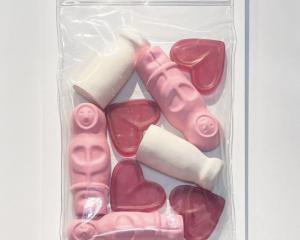Artist and Mint Gallery owner Murray Eskdale is exhibiting six large photographic works within his own ever-stylish art space.
Captured during his recent excursion to the United Kingdom, the photographs depict elaborate architectural sites and, being super-glossy and mounted upon aluminium, the photographs' individual presentation is as contemporary as the subject matter.
Eskdale clearly has an eye for visual harmony and the symmetry of these works - while denying equilateral "sameness" - is perfect. One might even be convinced that his desire for equilibrium is something less akin to an aesthetic preference and something closer to an expressive need. Such is not the signal of a formulaic artist who relies upon a preordained blueprint, but rather, an indication of an attentive photographer who is cognisant enough to recognise and exploit artistic configurations as and when they form.
The confidence with which this is said stems from the fact that the appearance of bustling crowds within public plazas (or indeed, the rare and fleeting moments when those crowds clear) cannot be arranged to satisfy the photographer's predilections. Hence, the artistry which underpins the exhibition springs from Eskdale's desire to step out of the crowd so as to, quite literally, notice the bigger picture. The results are hypnotic, articulate, and polished.
Opposite Structurally Sound is Richard Munro's Sanguine. "Sanguine" (derivative of the Latin "sanguineus") is French for "blood", but in English the term refers to a kind of red chalk which has, for centuries, been used for sketching and life-drawing.
With titles such as Haemoglobin and Eschar Munro presents large vinyl prints: two portraits derived from stencilled street art which Munro has photographed and manipulated, and three ostensibly abstract pieces in red, black and white - the first being the leading visual link. There is also a stand-alone set of three elongated canvases (though not a triptych) referencing the 1980s arcade video game Space Invaders which is a fashionably retro addition to the already modish collection.
The references to blood arrive in globular form: condensating bubbles rising like rushing blood; a diagrammatic array of red spheres mapped with thick black lines upon a white expanse (as if Mondrian had been charting medical science), or amidst the two, seemingly blood-washed faces which emerge from their inky encasement.
It seems a deliberate witticism that the sanguine-chalk reference underscores the exhibition's very absence of such age-old conventions. Photoshop, street-art and vinyl reign willingly supreme and if Munro's desire was to outshine archaic media, then he has done so to a neat and darkly satisfying end.
With each new semester the walls across four floors of the University of Otago's Richardson Building are graced with new-fangled artworks from the students of Dunedin's School of Art. The current selection, which adds a particularly challenging twist to the Faculty of Law, features works from 13 different textile artists in a broad-ranging exhibition, which was curated by the much-accomplished Desi Liversage.
Textile arts (which can range from objects constructed from plant and animal products through to synthetic fabrics) are steeped in assumptions pertaining to the feigned divides between craft and fine art, masculine and feminine modes of expression and decorative versus functional design. In light of such antiquated and patriarchal binaries, contemporary textile arts are not only valuable by way of the intensive labour and skill they tend to necessitate but also by virtue of the hugely political questions to which they give rise.
The works in this exhibition, unfortunately too many to describe here, comprise materials from dyed muslin to recycled plastic bags and yet it is the consideration and protestation inimitably woven into each piece which is the overwhelming and consistent quality. Whether it is via the meticulous handicraft, the soulful originality or the assorted expressions of critical awareness, these works boldly represent journeys from the inside out.
- Franky Strachan.








![Untitled (c. mid 1990s, [pink 3]), by Martin Thompson, 415mm×590mm. Photo: courtesy of Brett...](https://www.odt.co.nz/sites/default/files/styles/odt_landscape_small_related_stories/public/story/2024/02/untitled_pink_3.jpg?itok=Q0aQrc9o)



